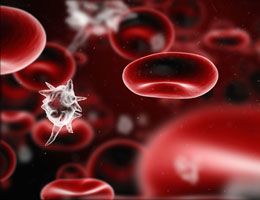Health library
Back to health libraryAcute leukemia: What to know

When you think of cancer, you may think of tumors in organs such as the lungs or liver. But leukemia is different. It’s a cancer of blood cells—most often white blood cells—which are manufactured in your bone marrow. They help your body fight infection.
There are several types of leukemia, and they can be broken down into two broad groups: chronic leukemia and acute leukemia. This article will focus on acute leukemia.
What are the symptoms?
Acute leukemia develops and progresses quickly. It has to be treated as soon as it’s diagnosed.
According to the American Academy of Family Physicians (AAFP), symptoms of acute leukemia can include:
- Fatigue.
- Shortness of breath.
- Pale skin.
- Low-grade fever.
- Night sweats.
- Bruising for no obvious reason.
- Achy bones and joints.
- Tiny red spots under the skin.
The causes of acute leukemia are rarely known. Although there are some things that can raise your risk—such as genetics or exposure to certain chemicals—most people with leukemia don’t have any risk factors, according to the AAFP.
Two types of acute leukemia
There are two types of acute leukemia: acute lymphocytic (or lymphoblastic) leukemia (ALL) and acute myeloid leukemia (AML).
ALL starts in early versions of white blood cells called lymphocytes. AML starts in early versions of myeloid cells—the cells that make red blood cells, platelets and white blood cells (except lymphocytes).
In both ALL and AML, abnormal cells multiply and build up in the bone marrow. They crowd out other, healthy blood cells—including white blood cells, red blood cells and platelets.
Too few of these healthy cells can lead to:
- Infections.
- Anemia.
- Bleeding and sudden bruising.
As leukemia cells multiply, they spill out of the bone marrow and into the bloodstream. From there, they may spread to organs like the liver, spleen and brain.
How is acute leukemia treated?
Both ALL and AML are commonly treated in phases, according to the American Cancer Society.
The first phase is called induction of remission. During this stage, chemotherapy drugs are used to destroy as many leukemia cells as possible. This initial treatment lasts for weeks and the patient usually stays in the hospital. Most people go into remission after this stage.
However, follow-up therapy is required to prevent a relapse.
Some people also are treated with stem cell transplants in which diseased bone marrow is replaced by healthy bone marrow donated by someone else.
If you’re diagnosed with ALL or AML, ask your doctor about joining a clinical trial that’s testing new treatments for the disease.
You can find information about chronic leukemia here.
Reviewed 6/2/2025
